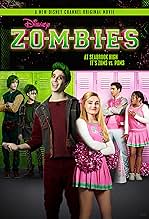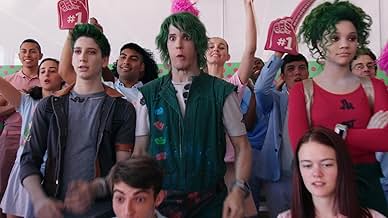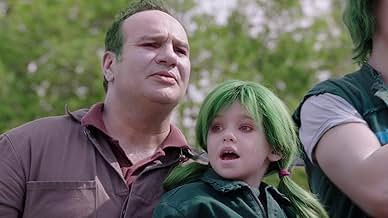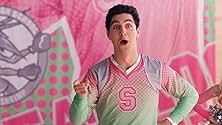Ajouter une intrigue dans votre langueStudents from Zombietown are transferred to a high school in a suburban town preoccupied with uniformity, traditions and pep rallies.Students from Zombietown are transferred to a high school in a suburban town preoccupied with uniformity, traditions and pep rallies.Students from Zombietown are transferred to a high school in a suburban town preoccupied with uniformity, traditions and pep rallies.
- Récompenses
- 2 nominations au total
Jasmine Renée Thomas
- Stacey
- (as Jasmine Renee Thomas)
Histoire
Le saviez-vous
- AnecdotesBased on the unaired sold TV pilot Zombies and Cheerleaders (2012).
- Crédits fousAt the end, "The End" is written on screen in the zombie language. Underneath, there's an English translation in parenthesis.
- ConnexionsFeatured in Musical Hell: Z-O-M-B-I-E-S (2019)
- Bandes originalesMy Year
Performed by Meg Donnelly, Milo Manheim, Kylee Russell, Trevor Tordjman & James Godfrey
Commentaire à la une
This teen love story is a tale of resistance, fighting for positive change, and finding common ground, accompanied by upbeat musical dance numbers and Disney's ever-present white-washing of history, which hangs over the film like a dark cloud. Z-O-M-B-I-E-S, which premiered on Disney Channel in 2018, is a dramatic but ultimately lighthearted musical geared for pre-teens and teens. This film dives into serious topics such as bias and prejudices, institutional racism, segregation and integration, forbidden love because of class status, and more. However, it does this in a very cleaned up "Disney-fied" sort of way, which means it is centered around a teen romance, singing and dancing, the cheer team, football, and a school dance. This musical is about humans who have been infected with a "zombie-virus" and the prejudices they are up against from the non-infected. My main problem with this film is that it uses Zombie-ism as a metaphor for race but doesn't speak directly about race/cultures, even though there are some pretty heavy-handed racially coded issues centrally in the plot. If this movie actually touched on real issues regarding race and didn't just use being infected as a metaphor for it, Z-O-M-B-I-E-S actually would have been even more meaningful to us viewers. But in the act of trying to use a disease as a metaphor this movie erased actual history to simplify its points.
This film depicts Zombietown as grungy and poor, with few legitimate businesses, which is one of the many ways the movie is trying to show us, the viewers, that they are using zombies as a stand-in for segregated communities of color. "Structural Racism is a system in which public policies, institutional practices, cultural representations, and other norms work in various, often reinforcing ways to perpetuate racial group inequity. It identifies dimensions of our history and culture that have allowed privileges associated with 'whiteness' and disadvantages associated with 'color' to endure and adapt over time." (Glossary for Understanding the Dismantling Structural Racism/Promoting Racial Equity Analysis, The Aspen Institute). This definition is word for word what the zombies are experiencing because of the systems set in place by Seabrook. Z-O-M-B-I-E-S is based in two places; the "perfect" town of Seabrook and a territory called Zombietown. There was an explosion at a power plant in Seabrook that caused some people to get a "zombie virus". People that were infected have been forced to live in Zombietown for 50 years, even though now they have been able to control the part of the virus that makes them aggressive and brain-eating. But now for the first time some teens from Zombietown will be able to attend Seabrook High. In depicting the housing in Zombietown as reminiscent of very low-income communities in segregated parts of America but to not mention actual segregation, is one of the many mistakes that came from using a disease outbreak as a white-washed metaphor for racism. Residential segregation of minority groups is still a major source of racial inequality in America to this day, which means it is much too important and real to act like it doesn't exist.
The main protagonists Addison and Zed are both "different", but I actually think this proves my point about how this movie creates problems for itself regarding race. Addison, who is trying out for the cheer team at Seabrook High has a secret: she has hair as white as snow so she wears a wig every day. Being popular and a cheerleader is all she has ever wanted, and has been able to uphold her own social status for her whole life behind her wig. Zed, who lives in Zombietown, will be in the first group of students from there ever to be integrated into Seabrook High. Zed just wants to join the football team and make friends, but things do not go as expected for Zed and the other students from Zombietown when they start at Seabrook. This is because at school they are still segregated and forced to learn in the bassment. Both of them are great performers, but the issue that I have is with the casting of the two main characters. Zed is played by Milo Manheim and Addison by Meg Donnelly. My problem isn't with them, but it is the whole "white savior complex" trope we see in so many stories (i.e. Harry Potter, Percy Jackson, Hunger Games, etc.). Addison and Zed are played by white actors, like in most Disney narratives. It means that this is just another movie where the main sympathetic "different" characters trying to create change are white people. To add to this, I found it notable that the way Addison is "different" is by having pure white hair. Even the fact of her difference still is about her just being very white. There is a lot of diversity in the film in relation to the casting, so in a film so central about prejudices, it seemed redundant to have the two main stars be played by the exact same types of characters that we are so used to seeing in these types of stories. Trying to use white people as a stand-in for metaphors about race is problematic and insensitive.
Z-O-M-B-I-E-S pulls at your heartstrings and has an ethos with seemingly good intentions. The dance numbers were fun to watch and the characters were lovable. This movie was designed to make you think it is something for the time, an insightful tale for the ages. But, through its many insensitivities and mistakes, some of the film's impact falls flat. Even though it's not "woke" enough for the next generation of youngsters, I can't deny that the musical numbers were pretty catchy. I mean, it is a Disney movie afterall.
This film depicts Zombietown as grungy and poor, with few legitimate businesses, which is one of the many ways the movie is trying to show us, the viewers, that they are using zombies as a stand-in for segregated communities of color. "Structural Racism is a system in which public policies, institutional practices, cultural representations, and other norms work in various, often reinforcing ways to perpetuate racial group inequity. It identifies dimensions of our history and culture that have allowed privileges associated with 'whiteness' and disadvantages associated with 'color' to endure and adapt over time." (Glossary for Understanding the Dismantling Structural Racism/Promoting Racial Equity Analysis, The Aspen Institute). This definition is word for word what the zombies are experiencing because of the systems set in place by Seabrook. Z-O-M-B-I-E-S is based in two places; the "perfect" town of Seabrook and a territory called Zombietown. There was an explosion at a power plant in Seabrook that caused some people to get a "zombie virus". People that were infected have been forced to live in Zombietown for 50 years, even though now they have been able to control the part of the virus that makes them aggressive and brain-eating. But now for the first time some teens from Zombietown will be able to attend Seabrook High. In depicting the housing in Zombietown as reminiscent of very low-income communities in segregated parts of America but to not mention actual segregation, is one of the many mistakes that came from using a disease outbreak as a white-washed metaphor for racism. Residential segregation of minority groups is still a major source of racial inequality in America to this day, which means it is much too important and real to act like it doesn't exist.
The main protagonists Addison and Zed are both "different", but I actually think this proves my point about how this movie creates problems for itself regarding race. Addison, who is trying out for the cheer team at Seabrook High has a secret: she has hair as white as snow so she wears a wig every day. Being popular and a cheerleader is all she has ever wanted, and has been able to uphold her own social status for her whole life behind her wig. Zed, who lives in Zombietown, will be in the first group of students from there ever to be integrated into Seabrook High. Zed just wants to join the football team and make friends, but things do not go as expected for Zed and the other students from Zombietown when they start at Seabrook. This is because at school they are still segregated and forced to learn in the bassment. Both of them are great performers, but the issue that I have is with the casting of the two main characters. Zed is played by Milo Manheim and Addison by Meg Donnelly. My problem isn't with them, but it is the whole "white savior complex" trope we see in so many stories (i.e. Harry Potter, Percy Jackson, Hunger Games, etc.). Addison and Zed are played by white actors, like in most Disney narratives. It means that this is just another movie where the main sympathetic "different" characters trying to create change are white people. To add to this, I found it notable that the way Addison is "different" is by having pure white hair. Even the fact of her difference still is about her just being very white. There is a lot of diversity in the film in relation to the casting, so in a film so central about prejudices, it seemed redundant to have the two main stars be played by the exact same types of characters that we are so used to seeing in these types of stories. Trying to use white people as a stand-in for metaphors about race is problematic and insensitive.
Z-O-M-B-I-E-S pulls at your heartstrings and has an ethos with seemingly good intentions. The dance numbers were fun to watch and the characters were lovable. This movie was designed to make you think it is something for the time, an insightful tale for the ages. But, through its many insensitivities and mistakes, some of the film's impact falls flat. Even though it's not "woke" enough for the next generation of youngsters, I can't deny that the musical numbers were pretty catchy. I mean, it is a Disney movie afterall.
- maddisonblessing-95623
- 7 oct. 2021
- Permalien
Meilleurs choix
Connectez-vous pour évaluer et suivre la liste de favoris afin de recevoir des recommandations personnalisées
Détails
- Date de sortie
- Pays d’origine
- Sites officiels
- Langue
- Aussi connu sous le nom de
- Disney Zombies
- Lieux de tournage
- Sociétés de production
- Voir plus de crédits d'entreprise sur IMDbPro
Contribuer à cette page
Suggérer une modification ou ajouter du contenu manquant








































